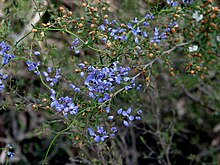Comesperma volubile
| Comesperma volubile | |
|---|---|

| |
| Scientific classification | |
| Kingdom: | Plantae |
| Clade: | Tracheophytes |
| Clade: | Angiosperms |
| Clade: | Eudicots |
| Clade: | Rosids |
| Order: | Fabales |
| Family: | Polygalaceae |
| Genus: | Comesperma |
| Species: | C. volubile
|
| Binomial name | |
| Comesperma volubile | |

| |
| Occurrence data from AVH | |
Comesperma volubile, commonly known as love creeper,[2] is a slender climber in the family Polygalaceae. It is a twining plant with linear leaves and pea-like blue flowers.[3]
Description[edit]
Comesperma voluble is a twining creeper to about 3 m (9.8 ft) high on rare occasion a small shrublet with smooth, angled stems. There are few leaves, linear to oval-shaped, 10–45 mm (0.39–1.77 in) long, 1.5–9 mm (0.059–0.354 in) wide, lower surface pale, margins curved or rolled under. The flowers are in lateral racemes 3–25 cm (1.2–9.8 in) long, the sepals are separated, outer three broadly oval-shaped, about 2 mm (0.079 in) long, wings oval-shaped to nearly orb-shaped, 4–7 mm (0.16–0.28 in) long, keel darker, 3.5–5 mm (0.14–0.20 in) long, upper petals egg-shaped to oblong. Flowering occurs mainly August to November and the fruit is a narrow wedge-shaped capsule, 12–20 mm (0.47–0.79 in) long.[3]
Taxonomy and naming[edit]
Comersperma voluble was first formally described in 1806 by Jacques Labillardière, and the description was published in Novæ Hollandiæ plantarum specimen.[4][5] The specific epithet (volubile) means "twining".[6]
Distribution and habitat[edit]
Love creeper occurs in heathland and forest in the states of Western Australia, South Australia, Tasmania, Victoria, New South Wales and Queensland, in Australia.[7]
References[edit]
- ^ "Comersperma volubile". Australian Plant Census. Retrieved 16 January 2023.
- ^ "Comesperma volubile". VIC FLORA-Flora of Victoria. Royal Botanic Garden Victoria.
- ^ a b "Comesperma volubile". PlantNET - New South Wales Flora Online. Royal Botanic Gardens & Domain Trust, Sydney Australia. Retrieved 2009-09-17.
- ^ "Comesperma volubile". Australian Plant Name Index, IBIS database. Centre for Plant Biodiversity Research, Australian Government.
- ^ Labillardière, Jacques Julien Houton de (1806), Novae Hollandiae Plantarum Specimen (in Latin), vol. 2, Paris: Ex typographia Dominæ Huzard, p. 24, t. 163, doi:10.5962/BHL.TITLE.62462, OCLC 7841612, Wikidata Q7064396
- ^ Sharr, Francis Aubi; George, Alex (2019). Western Australian Plant Names and Their Meanings (3rd ed.). Kardinya, WA: Four Gables Press. p. 347. ISBN 9780958034180.
- ^ Wild Plants of Victoria (database). Viridans Biological Databases & Department of Sustainability and Environment. 2009.
